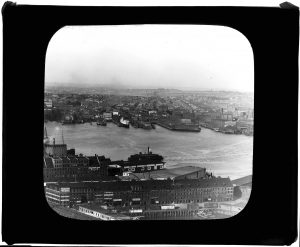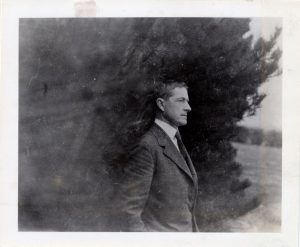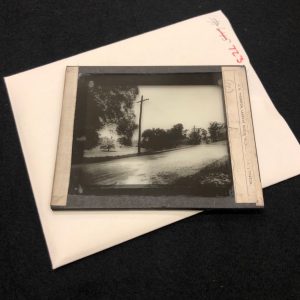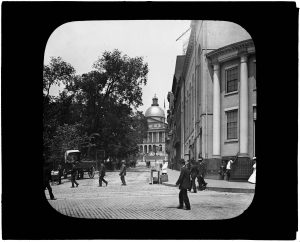by Alexandra Bush, Digital Production Assistant
The MHS is proud to announce a newly available digital collection. Prominent Boston landscape architect Arthur Asahel Shurcliff created this collection of more than 1,200 glass lantern slides, spanning 90 physical boxes, which the MHS acquired in the 1960s. There are many rationales for the digitization of an MHS collection. In this case, the fragility of these glass slides along with the absence of the appropriate projection equipment makes in-person viewing difficult. However, a high-resolution scan reveals a diverse array of subject matter; city planning maps and diagrams, historic images of Boston’s streets and landmarks, snapshots from Shurcliff’s travels abroad, and more.

Arthur Asahel Shurcliff, born in 1870, enjoyed a long career as a landscape architect in Boston and beyond. He worked closely with Frederic Law Olmsted and his son, with whom he developed the first landscape architecture program at Harvard. Through his interest in urban beautification and landscape-based history, Shurcliff played integral roles in projects such as the restoration of Colonial Williamsburg, the 1920s additions to the Back Bay Fens including the athletic track and Kelleher Rose Garden, and the reinvention of the Charles River Esplanade, among many others. He also dreamt of a transit ring encircling Boston which, although never realized, would have revolutionized the city’s traffic flow. Shurcliff married Margaret Homer Nichols in 1905 with whom he had six children. Margaret is described by the Nichols House Museum as a “spirited woman” whose wealth did not interfere with her social conscience. She spent her spare time teaching carpentry to inner city children and lobbying for women’s suffrage. The two were known to design and build wooden furniture together.

As President of the American Society of Landscape Architects as well as a member of the Boston Arts Commission, Shurcliff worked often with prominent individuals and organizations such as Boston’s Metropolitan District Commission and Metropolitan Planning Board. It is evidence of this work combined with that of his development of the Harvard program with Frederic Law Olmsted, Jr. that allows us to surmise that his collection of lantern slides was likely used for lectures to students or professionals in the landscape architecture field. In fact, entries in Shurcliff’s diaries, also held at the MHS, record frequent trips to various locales, camera in tow, with the aim of “preparing slides” for lectures. (Please see 23-28 February, 1923 diary entries, Arthur Asahel Shurcliff Papers, carton 7.)
Often treated as in this case as a precursor to the modern-day overhead transparency, lantern slides were popularized around 1849 but were still in use as late as the 1930s. Hand-painted scenes as well as those produced using photographic negatives, which were created both commercially as well as by amateurs using take-home kits, were used in conjunction with a light projector to produce images. These projected images were used for a variety of purposes from magic shows to academic lectures. In Shurcliff’s case, although most of the slides are without labels, it is safe to assume that the collection was created using a mixture of commercial and self-produced photography, along with photographs of paper documents such as maps or diagrams.

The Shurcliff Collection of Glass Lantern Slides (Photo. Coll. 6.19) boasts an interesting and varied range of subjects. Those familiar with downtown Boston will enjoy paging through images of it from over 100 years in the past. Those interested in demographics will find the charts recording changes in the populations, traffic, and city planning priorities enlightening. Those in search of evidence of Americans abroad may find Shurcliff’s architecturally-minded, photographic diary of his travels through Southeast Asia to be an especially unique example. This fascinating collection is described in the online collection guide, which also includes links to the online presentation of each image. Please explore the collection guide. The web displays of the lantern slides are also now discoverable via MHS’s general website search tool.
The MHS is grateful to the Boston Public Library for creating the master digital images of the lantern slides. The Library for the Commonwealth program of the Boston Public Library supports digitization services for a statewide collaborative project, Digital Commonwealth of Massachusetts. In the near future, metadata relating to the Shurcliff lantern slides will be added to Digital Commonwealth’s online discovery portal, where people can search across thousands of collections from various cultural institutions in Massachusetts. In the meantime check out other digitized MHS collections currently on Digital Commonwealth.

Further reading
- Cushing, Elizabeth Hope. Arthur A. Shurcliff: Design, Preservation, and the Creation of the Colonial Williamsburg Landscape. Amherst: University of Massachusetts Press, in association with Library of American Landscape History, 2014.
- Shurcliff, Arthur A. Autobiography of Arthur A. Shurcliff: written winter of 1943- 1944, with additions summer of 1946, summer of 1947. 1981.
- Todisco, Patrice. “Boston’s Charles River Esplanade: an urban jewel,” Landscape Notes, 2015. https://landscapenotes.com/2015/03/07/bostons-charles-river-esplanade-an-urban-jewel/
- “Margaret Homer (Nichols) Shurcliff (1879-1959),” Nichols House Museum, 2019. https://www.nicholshousemuseum.org/margaret_nichols.php
- Arthur Asahel Shurcliff papers, Massachusetts Historical Society. https://www.masshist.org/collection-guides/view/fa0023

